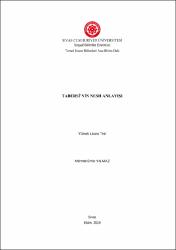| dc.contributor.advisor | Keskin, Hasan | |
| dc.contributor.author | Yılmaz, Mehmet Emin | |
| dc.date.accessioned | 2020-03-04T12:08:40Z | |
| dc.date.available | 2020-03-04T12:08:40Z | |
| dc.date.issued | 2019 | tr |
| dc.date.submitted | 2019-10-23 | |
| dc.identifier.other | IX, 101 sayfa | |
| dc.identifier.uri | https://hdl.handle.net/20.500.12418/12338 | |
| dc.description.abstract | Bu çalışmada hicrî 5. yüzyılın en önemli Şiî-İmamiyye âlîmlerinden biri olan Tabersî’nin eserlerinde tefsîr usûlünün temel kavramlarından biri olan neshin mahiyeti ve pratiğini inceledik.“Tabersî’nin Nesh Anlayışı” adlı tezimiz, üç ana bölüm ve sonuç bölümünden oluşmaktadır. Birinci bölümde Ehl-i Sünnetin ve Şia-İmamiyye’nin nesh anlayışını ortaya koymaya çalıştık.
İkinci bölümde ise Tabersî’nin hayatı ve yaşadığı çağda fikrî ve siyasî durumu, ilmî kişiliği ve bazı itikâdî görüşlerini açıkladık.
Üçüncü bölümde ise Tabersî’nin nesih tanımı ve neshin mahiyeti ile ilgili görüşleri tespit etmeye çalıştık. Tabersî, Kur’ân’da neshi (“metni mensûh hükmü bâkî”, “hükmü mensûh metni bâkî” ve “hükmü ve metni mensûh” şeklinde) kategorik olarak ayırmakta ve “Mecmaû’l- Beyân Fî Tefsîri’l-Kur’ân” isimli eserinde detaylı bir biçimde bu konuyu incelemektedir. Tabersî, Kur'ân ve sünnette neshi kabul ederken icmâ ve kıyasın neshini reddetmektedir.
Tabersî’nin tefsîrinde âyetler arasında neshi nasıl incelediğini araştırdık. Tabersî tefsîrinde çoğunlukla İbn Abbâs (ö. 68/687) ve tâbiûn dönemi müfessirlerinin görüşlerine yer verirken bazen kendi kanaatlerini dile getirmektedir. Tabersî’nin tefsîrini incelerken i’tidalli bir âlim olduğunu gördük. Mezhepçilikten uzak bir uslüba sahip bir şahsiyet. | tr |
| dc.description.abstract | We examined Tabersî who is one of the most important shii imamiya scholars of the 5th century in this study, the nature and practice of the neshin, one of the the basic concepts of tafsir method in the works of Tabersî.The so- called “Tabersî sence of nesh” composed of three main sections and a result section. In the first chapter we tried to reveal the nesh understanding the people of the Sunnah and the Shia imamiya. In the second part, we explained the political and political situation scientific personality and some beliefs of the Tabersî.
In the third part, Tabersî’s views about the definition of the nesh and the nature of the nesh are explained. Tabersî in Kur’ân neshi (in the form of “textual judges” judgment texts and judges and texts) separates category in the form of “mecmau’l declaration fi tefsîri’l Kur’ân”. Tabersî accepts nesh in circumcision while rejecting the rime and the nesh of comparison.
Then we told how examine neshi among the verses in the commentary of Tabersî. In the commentary of Tabersî, it mostly includes the views of İbn Abbas (d.68/67) and the commentators of the period. Sometimes we express his own convictions. At the same time, it makes difficult for us to determine the option of the Tabersî’s view. A general salvation was made in the result part. | tr |
| dc.language.iso | tur | tr |
| dc.publisher | Sivas Cumhuriyet Üniversitesi - Sosyal Bilimler Enstitüsü | tr |
| dc.rights | info:eu-repo/semantics/openAccess | tr |
| dc.subject | Nesh | tr |
| dc.subject | Mensûh | tr |
| dc.subject | Ehl-i Sünnet | tr |
| dc.subject | Şia | tr |
| dc.subject | Tabersî | tr |
| dc.title | Tabersi'nin Nesh Anlayışı | tr |
| dc.type | masterThesis | tr |
| dc.contributor.department | Sosyal Bilimler Enstitüsü | tr |
| dc.relation.publicationcategory | Tez | tr |















